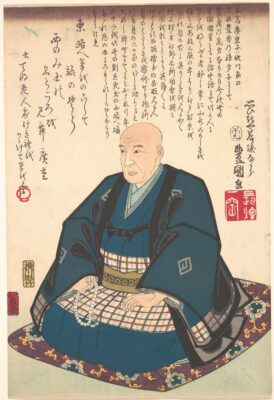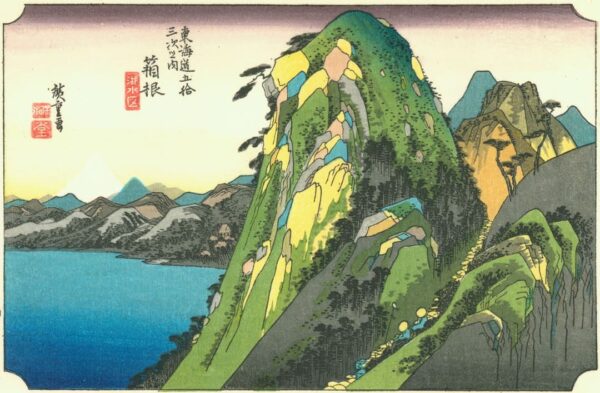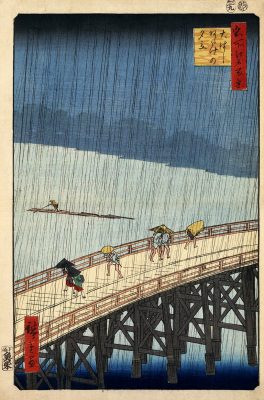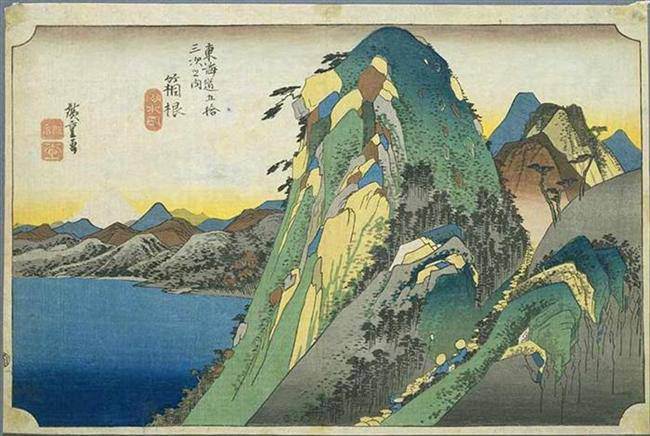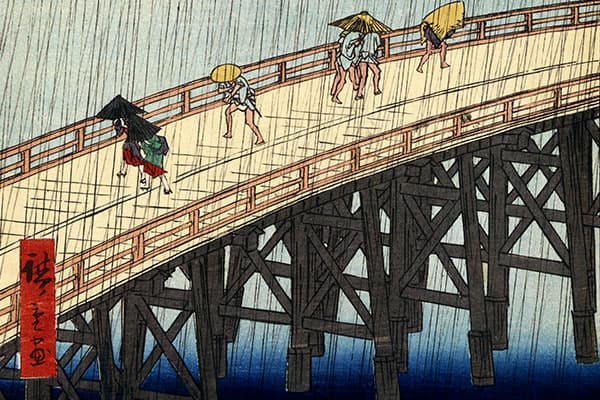Hiroshige
Dejo mi pincel en el Este
Utagawa Hiroshige
y emprendo mi viaje.
Veré los lugares famosos del mundo occidental
Si bien por la importancia de su obra es Hokusai el artista que merece figurar en el puesto más alto de los grabadores japoneses del siglo XIX, fue Utagawa Hiroshige el que llevó este género a su más alta expresión. En comparación con las obras de Hokusai, en los grabados de Hiroshige «el movimiento y la acción presentan una mayor calma, más sutileza, que dota a sus paisajes de un contenido poético» (Historia Universal de la Pintura, Espasa Calpe, Tomo VIII, 1997). Para David Almazán Tomás y Elena Barlés Báguena («Hiroshige, maestro del paisaje del grabado japonés»), Hiroshige «da un paso más y logra atrapar con inmediatez las impresiones instantáneas de los paisajes en el fluctuante paso de las estaciones y en los variables momentos del día«. La muerte de Hiroshige, acontecida en 1858, supone el declive definitivo de la escuela ukiyo-e.
Imagen: Utagawa Kunisada: “Retrato de Hiroshige”. Grabado en madera policromada, 36.2 x 24.4 cm
Hiroshige, cuyo verdadero nombre era Andō Tokutarō, nació en Edo (hoy Tokio) en los últimos años del siglo XVIII. Mostró muy pronto una atracción por la pintura, por lo que de niño entró a estudiar en el taller del artista Utagawa Toyohiro. Aunque sabemos que ya con quince años se le permitía firmar sus propias obras, se tiene poca información sobre la etapa juvenil del artista. Cuando su maestro falleció, en 1828, Hiroshige rechazó sucederle como maestro, manteniendo su seudónimo en lugar de cambiarlo a Toyohiro II.
Es entonces cuando comienza la etapa de madurez del artista. Crea primero su serie de “Ocho vistas de Ōmi”, que sirve como prólogo a su “Las cincuenta y tres estaciones de Tōkaidō”, una de las obras más importantes de la escuela ukiyo-e. Inspirada por la serie “Treinta y seis vistas del monte Fuji” de Hokusai, la serie de Hiroshige destaca por lo variado de sus escenas, que abarcan desde grandiosos paisajes sin presencia humana (“10ª estación: Hakone, rocas altas junto a un lago”) hasta paisajes urbanos (35ª estación: Goyu) incluyendo escenas casi costumbristas en las que el artista se esfuerza por representar efectos atmosféricos (Estación 45 : Shōno. Viajeros sorprendidos por lluvia repentina).
Utagawa Hiroshige: “10ª estación: Hakone, rocas altas junto a un lago”, de la serie “Las cincuenta y tres estaciones de Tōkaidō”. Grabado, 1833-34. 24.1 x 35.9 cm ·· Utagawa Hiroshige: “El puente Ōhashi en Atake bajo una lluvia repentina”, de la serie “Cien famosas vistas de Edo”. Grabado, 1857-59. 37 x 25 cm.
Pero, si bien “Las cincuenta y tres estaciones de Tōkaidō” es una serie de importancia, la verdadera obra maestra de Hiroshige, y la cumbre del ukiyo-e junto con la serie de Hokusai mencionada anteriormente, es “Cien famosas vistas de Edo”, una serie de 119 obras creadas entre 1856 y 1858, cuya impresión no sería completada hasta después de la muerte del artista. En formato vertical, Hiroshige describe la vida y los paisajes en Edo. La obra más célebre de la serie, “El puente Ōhashi en Atake bajo una lluvia repentina” fue escogida por theartwolf en 2006 como una de las 50 obras maestras de la pintura.
Inspirado sin duda por la serie homónima de Hokusai, Hiroshige creó la serie de “Treinta y seis vistas del monte Fuji”, serie que publicó en dos partes, una en formato horizontal y otra en formato vertical. Falleció a los 62 años, víctima de una epidemia de cólera. Sus obras, quizás incluso más que las de Hokusai, tuvieron una influencia colosal en la pintura de Vincent van Gogh, quien llegó no solo a incluirlas como fondo de sus obras, sino a copiar varias de las pinturas del maestro japonés, como la ya mencionada “El puente Ōhashi en Atake bajo una lluvia repentina”.
G. Fernández · theartwolf.com
Más sobre Hiroshige
Follow us on:

